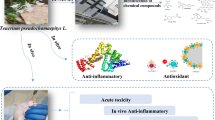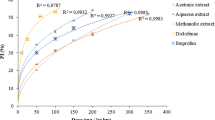Abstract
Campomanesia xanthocarpa (Myrtaceae) is used in Brazilian traditional medicine against fever, diabetes, hypercholesteremic, obesity, and urinary diseases. In the present study, the compounds 2′,6′-dihydroxy-3′-methyl-4′-metoxychalcone and 2′,4′-dihydroxy-3′,5′-dimethyl-6′-methoxychalcone were identified for the first time in leaves of the C. xanthocarpa. These compounds and the hydroethanolic extract (HECX) significantly inhibited paw edema and reduced both leukocyte migration and the leakage of protein into the pleural cavity. No toxicity was detected by HECX in an acute toxicity test.



Similar content being viewed by others
References
Wilson, P.G., M.M. O’Brien, P.A. Gadek, and C.J. Quinn. 2001. Myrtaceae revised: a reassessment of intrafamilial groups. American Journal of Botany 88: 2012–2025.
Landrum, L.R. 1986. Campomanesia, pimenta, blepharocalyx, legrandia, acca, myrrhinium, and luma (myrtaceae). Flora Neotropica 45: 1–178. Retrieved from http://www.jstor.org/stable/.
Ferreira, L.C., A.G. Guimarães, C.A. Paula, M.C.P. Michel, R.G. Guimarães, S.A. Rezende, J.D. Souza-Filho, and D.A.S. Guimarães. 2013. Anti-inflammatory and antinociceptive activities of Campomanesia adamantium. Journal of Ethnopharmacology 145: 100–108.
Michel, M.C.P., A.G. Guimarães, C.A. Paula, S.A. Rezende, M.E.G. Sobral, and D.A.S. Guimarães. 2013. Extracts from the leaves of Campomanesia velutina inhibits production of LPS/INF-γ induced inflammatory mediators in J774A.1 cells and exerts anti-inflammatory and antinociceptive effects in vivo. Revista Brasileira Farmacognosia 23: 927–936. doi:10.1590/S0102-695X2013000600010.
De Souza, J.C., A.C. Piccinelli, D.F. Aquino, V.V. De Souza, W.O. Schmitz, G.K. Traesel, C.A.L. Cardoso, C.A. Kassuya, and A.C. Arena. 2014. Toxicological analysis and antihyperalgesic, antidepressant, and anti-inflammatory effects of Campomanesia adamantium fruit barks. Nutritional Neuroscience 0(0): 1–9. doi:10.1179/1476830514Y.0000000145.
Trojan-Rodrigues, M., T.L.S. Alves, and G.L.G. Soares. 2012. Plants used as antidiabetics in popular medicine in Rio Grande do Sul, Southern Brazil, Ritter, M.R. Journal of Ethnopharmacology 139: 155–163.
Biavatti, M.W., C. Farias, F. Curtius, L.M. Brasil, S. Hort, L. Schuster, S.N. Leite, and S.R.T. Prado. 2004. Preliminary studies on Campomanesia xanthocarpa (Berg.) and Cuphea carthagenensis (Jacq.) J. F. Macbr. Aqueous extract: weight control and biochemical parameters. Journal of Ethnopharmacology 93(2–3): 385–389.
Dickel, M.L., S.M.K. Rates, and M.R. Ritter. 2007. Plants popularly used for loosing weight purposes in Porto Alegre, South Brazil. Journal of Ethnopharmacology 109: 60–71.
Correa, M.P. 1926. Dicionário das plantas úteis do Brasil e das exóticas cultivadas. Vol I. Rio de Janeiro: Imprensa Nacional. 747pp.
Klafke, J.Z., M.A. Silva, T.F. Panigas, K.C. Belli, M.F. Oliveira, M.M. Barichello, F.K. Rigo, M.F. Rossato, A.R.S. Santos, M.G. Pizzolatti, J. Ferreira, and P.R.N. Viecili. 2010. Effects of Campomanesia xanthocarpa on biochemical, hematological and oxidative stress parameters in hypercholesterolemic patients. Journal of Ethnopharmacology 127(2): 299–305.
Viecili, P.R.N., D.O. Borges, K. Kirsten, J. Malheiros, E. Viecili, R.D. Melo, G. Trevisan, M.A. Silva, G.V. Bochi, R.N. Moresco, and J.Z. Klafke. 2014. Effects of Campomanesia xanthocarpa on inflammatory processes, oxidative stress, endothelial dysfunction and lipid biomarkers in hypercholesterolemic individuals. Atherosclerosis 234: 85–92.
Klafke, J. Z., Silva, M. A., Rossato, M. F., Trevisan,G., Walker, C. I. B., Leal, C. A. M., Borges, D. O., Schetinger, M. R. C., Moresco, R. N., Duarte, M. M. M. F., Santos, A. R. S., Viecili, P. R. N., Ferreira, J. 2012. Antiplatelet, Antithrombotic, and Fibrinolytic Activities of Campomanesia xanthocarpa. Evidence-Based Complementary and Alternative Medicine 954748.
Santos, M.S., O.G. Miguel, C.L.O. Petkowicz, and L.M.B. Cândido. 2012. Antioxidant and fatty acid profile of gabiroba seed (Campomanesisa Xanthocarpa Berg). Food Science and Technology 32(2): 234–238.
Vinagre, A.P.S., A.D.S.R.O. Rônnau, S.F. Pereira, L.U. Silveira, E.F. Wiilland, and E.S. Suyenaga. 2010. Anti-diabetic effects of Campomanesia xanthocarpa (Berg) leaf decoction. Brazilian Journal of Pharmaceutical Sciences 46(2): 169–177.
Markman, B.E.O., E.M. Bacchi, and E.T.M. Kato. 2004. Antiulcerogenic effects of Campomanesia xanthocarpa. Journal of Ethnopharmacology 94(1): 55–57.
Cavalcanti, Y.W., Ana L.A.L. Pérez, G.D.R. Xavier, L.F.D. Almeida, and W.W.N. Padilha. 2012. Atividade Antifúngica de Extratos Vegetais Brasileiros sobre Cepas de Candida. Revista Brasileira de Ciências da Saúde 16(1): 43–48. doi:10.4034/RBCS.2012.16.01.07.
Pastori, T., F.C. Flores, A.A. Boligon, M.L. Athayde, C.B. Silva, T.S. Canto-Dorow, and S.B. Tedesco. 2013. Genotoxic effects of Campomanesia xanthocarpa extracts on Allium cepa vegetal system. Pharmaceutical Biology 51(10): 1249–1255. doi:10.3109/13880209.2013.786097.
Auharek, S.A., M.C. Vieira, C.A.L. Cardoso, R.J. Oliveira, and A.L. Cunha-Laura. 2013. Reproductive toxicity of Campomanesia xanthocarpa (Berg.) in female Wistar rats. Journal of Ethnopharmacology 148: 341–343.
Cardoso, C.A.L., M.J. Salvador, J.E. Carvalho, and R.G. Coelho. 2013. Avaliação das atividades antiproliferativa e antioxidante em frutos de Campomanesia pubescens. Revista do Instituto Adolfo Lutz 72(4): 309–315. Disponível em: <http://revistas.bvs-vet.org.br/rialutz/article/view/22897>.
Lin, J.Y., and C.Y. Tang. 2007. Determination of total phenolic and flavonoid contents in selected fruits and vegetables, as well as their stimulatory effects on mouse splenocyte proliferation. Food Chemistry 101: 140–147.
Djeridane, A., M. Yousfi, B. Nadjemi, D. Boutassouna, P. Stocker, and N. Vidal. 2006. Antioxidant activity of some algerian medicinal plants extracts containing phenolic compounds. Food Chemistry 97: 654–660.
Broadhurst, R.B., and W.T. Jones. 1978. Analysis of condensed tannins using acidified vanillin. Journal of the Science of Food and Agriculture 29: 788–794.
Agostini-Costa, T.S., D.S. Garruti, L. Lima, S. Freire, F.A.P. Abreu, and T. Feitosa. 1999. Avaliação de metodologias para determinação de taninos no suco de caju. Boletim Centro de Pesquisa de Processamento de Alimentos 17: 167–176.
Harborne, J.B. 1995. The flavonoids. Advances in research since 1986 (Harbone, J.B.). Journal Chemycal Education 72(3): A73. doi:10.1021/ed072pA73.11.
Resurreccion-Magno, M.H.C., I.M. Villasenor, N. Harada, and K. Monde. 2005. Antihyperglycaemic flavonoids fromSyzygium samarangense(Blume) merr. and Perry. Phytotherapy Research 19(3): 246–251.
Mustafa, K.A., N.B. Perry, and R.T. Weavers. 2005. Lipophilic C-methylflavonoides with no B-ring oxigenation in Metrosideros species (Myrtaceae). Biochemical Systematics and Ecology 33(10): 1049–1059.
Agrawal P. K. 1989. Carbon-13 NMR of Flavonoids. Elsevier Science, Amsterdam. p. 564. ISBN 0-444-87449-6
Kassuya, C.A., A. Cremoneze, L.F. Barros, A.S. Simas, F.R. Lapa, R. Mello-Silva, M.E. Stefanello, and A.R. Zampronio. 2009. Antipyretic and anti-inflammatory properties of the ethanolic extract, dichloromethane fraction and costunolide from Magnolia ovata (Magnoliaceae). Journal of Ethnopharmacology 124: 369–376.
Santos, J.A., A. Arruda, M.A. Silva, C.A.L. Cardoso, M.C. Vieira, C.A.L. Kassuya, and A.C. Arena. 2012. Anti-inflammatory effects and acute toxicity of hydroethanolic extract of Jacaranda decurrens roots in adult male rats. Journal of Ethnopharmacology 144: 802–805.
Ramos, D.D., C.A.L. Cardoso, and N.T. Yamamoto. 2007. Avaliação do potencial citotóxico e atividade antioxidante em Campomanesia adamantium (Cambess.) O. Berg. (Myrtaceae). Brazilian Journal of Bioscienses 5(S2): 774–776.
Coutinho, I.D., R.G. Coelho, V.M.F. Kataoka, N.K. Honda, J.R.M. Silva, W. Vilegas, and C.A.L. Cardoso. 2008. Determination of phenolic compounds and evaluation of antioxidant capacity of Campomanesia adamantium leaves. Ecletica Quimica 33(4): 53–60.
Pavan, F.R., C.Q.F. Leite, R.G. Coelho, I.D. Coutinho, N.K. Honda, C.A.L. Cardoso, W. Vilegas, S.R. Leite, and A. De. 2009. Evaluation of anti- Mycobacterium tuberculosis activity of Campomanesia adamantium (MYRTACEAE). Quimica Nova 32(5): 1222–1226.
Cardoso, C.A.L., G.R. Salmazzo, N.K. Honda, C.B. Prates, C. Vieira Mdo, and R.G. Coelho. 2010. Antimicrobial activity of the extracts and fractions of hexanic fruits of Campomanesia species (Myrtaceae). Journal of Medicinal Food 13(5): 1273–1276.
Kataoka, V. M. F., Cardoso, C. A. L. 2013. Avaliação do perfil cromatográfico obtidos por CLAE-DAD e da atividade antioxidante das folhas de espécies Campomanesia sessiliflora (O. Berg) Mattos e Campomanesia xanthocarpa O. Berg. Revista Brasileira de Plantas Medicinais 15(1): 121–129. ISSN:1678–7064. doi:10.1590/S0100-40422009000500026.
Santos, M.S., J.J. Lima, C.L.O. Petkowicz, and L.M.B. Candido. 2013. Chemical characterization and evaluation of the antioxidant potential of gabiroba jam (Campomanesia xanthocarpaBerg). Acta Scientiarum Agronomy 35(1): 73–82.
Coutinho, I.D., V.M.F. Kataoka, N.K. Honda, R.G. Coelho, M.C. Vieira, and C.A.L. Cardoso. 2010. Influência da variação sazonal nos teores de flavonóides e atividade antioxidante das folhas de Campomanesia adamantium (Cambess.) O. Berg, Myrtaceae. Revista Brasileira de Farmacognosia 20(3): 322–327.
Oliveira, A.M., L.M. Conserva, J.N.S. Ferro, F.A. Brito, R.P.L. Lemos, and E. Barreto. 2013. Antinociceptive and anti-inflammatory effects of octacosanol from the leaves of Sabicea grisea var. grisea in mice. International Journal of Molecular Sciences 13(2): 1598–1611. doi:10.3390/ijms13021598.
Barros, F.E.V., M.G.T. Sousa, J.L. Costa, R.S.G. Olea, S.M.F. Freire, A.C.R. Borges, and M.O.R. Borges. 2004. Avaliação das atividades analgésica e antinflamatória do extrato metanólico de Calotropis procera R. BR. (ciúme). Infarma Ciências Farmacêuticas 16(9): 60–64.
Capó, J. T., Ávila, M. C. R., Méndez, I. C., Domínguez, C. C. 2002. Actividad antiinflamatoria de extractos de derivados de la caña de azúcar. Revista Cubana de Plantas Medicinales, Havana 7(2):1–3. citado 2016-03-09,. Disponible en: <http://scielo.sld.cu/scielo.php?script=sci_arttext&pid=S10287962002000200004&lng=es&nrm=iso>. ISSN 1028–4796.
Kassuya, C.A.L., A. Silvestre, O.M. Lima Junior, D.M. Marotta, V.L.G. Rehder, and J.B. Calixto. 2006. Antiinflammatory and antiallodynic actions of the lignan niranthin isolated from Phyllanthus amarus evidence for interaction with platelet activating factor receptor. European Journal of Pharmacology 546: 182–188.
Cabrini, D.A., H.H. Moresco, P. Imazu, C.D. Silva, and E.F. Pietrovski. 2011. Analysis of the potential topical anti-inflammatory activity of Averrhoa carambola L. in mice. Evidence-based Complementary Alternative Medicine 2011: 908059. doi:10.1093/ecam/neq026.
Di Rosa, M., J.P. Giroud, and D.A. Willoughby. 1971. Studies on the mediators of the acute inflammatory response induced in rats in different sites by carrageenan and turpentine. Journal of Pathology 104: 15–44.
Author information
Authors and Affiliations
Corresponding authors
Ethics declarations
Conflict of Interest
The authors declare that they have no conflict of interest.
Ethical Approval
All applicable international, national, and/or institutional guidelines for the care and use of animals were followed. All procedures performed in studies involving animals were in accordance with the ethical standards of the institution or practice at which the studies were conducted. According to the Ethics Committee on Animal Use the Federal University of Grande Dourados, Dourados, Mato Grosso do Sul, Brazil (CEUA/UFGD). This work was found to comply with the ethical concepts required by the National Council for Animal Experiments Control (CONCEA), with current legislation and other provisions of the ethics investigations that directly involve the use of animals and was approved on April 9, 2014, through the protocol number 028/2014.
Rights and permissions
About this article
Cite this article
da Silva, É.R.S., Salmazzo, G.R., da Silva Arrigo, J. et al. Anti-inflammatory Evaluation and Toxicological Analysis of Campomanesia xanthocarpa Berg. Inflammation 39, 1462–1468 (2016). https://doi.org/10.1007/s10753-016-0378-3
Published:
Issue Date:
DOI: https://doi.org/10.1007/s10753-016-0378-3




